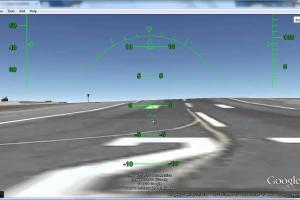Unlocking the Skies: Your Complete Guide to Mastering the Google Earth Flight Simulator

-
Quick Links:
- 1. Introduction
- 2. System Requirements
- 3. Getting Started
- 4. Understanding the Controls
- 5. Features of Google Earth Flight Simulator
- 6. Advanced Techniques for Flying
- 7. Troubleshooting Common Issues
- 8. Real-World Applications and Case Studies
- 9. Expert Insights
- 10. FAQs
1. Introduction
Google Earth has transformed the way we explore the planet. Among its many features, the Flight Simulator stands out as a unique tool that allows users to experience flying without leaving their homes. In this comprehensive guide, we will delve into how to use the Google Earth Flight Simulator, from installation to advanced flying techniques.
2. System Requirements
Before diving into the simulator, ensure your system meets the following requirements:
- Operating System: Windows 7 or later, macOS 10.10 or later
- RAM: At least 4 GB
- Graphics Card: OpenGL 2.0 compatible
- Internet Connection: Required for downloading Google Earth
3. Getting Started
To start using the Google Earth Flight Simulator, follow these simple steps:
- Download Google Earth: Visit the official Google Earth website to download the application.
- Install the Application: Follow the installation prompts to set up Google Earth on your device.
- Launch Google Earth: Open the application and familiarize yourself with the interface.
- Access the Flight Simulator: Press Ctrl + Alt + A (Windows) or Command + Option + A (macOS) to enter the Flight Simulator mode.
4. Understanding the Controls
The controls for the Google Earth Flight Simulator can be somewhat different from traditional flight simulators. Here’s a breakdown:
- Throttle: Use the up and down arrow keys to control speed.
- Pitch Control: Use the left and right arrow keys to adjust the pitch.
- Yaw Control: The A and D keys control the yaw.
- Roll Control: Use the Q and E keys to roll the aircraft.
5. Features of Google Earth Flight Simulator
Google Earth Flight Simulator comes with several features that enhance the flying experience:
- Multiple Aircraft Options: Choose from various aircraft, including commercial jets and small planes.
- Real-World Locations: Fly over any location on Earth, experiencing stunning satellite imagery.
- Flight Paths: Plan your flight path or choose from predefined routes.
- Weather Conditions: Experience real-time weather changes as you fly.
6. Advanced Techniques for Flying
Once you're comfortable with basic controls, consider these advanced techniques to improve your flying skills:
- Using GPS Coordinates: Entering GPS coordinates allows you to navigate to specific locations effortlessly.
- Practice Landing: Start by flying low and practicing landing techniques in various terrains.
- Explore Night Flying: Experience the differences in navigation and visibility when flying at night.
7. Troubleshooting Common Issues
While using Google Earth Flight Simulator, you may encounter some common issues:
- Slow Performance: Ensure your graphics drivers are updated and close unnecessary applications.
- Control Issues: Check the keyboard settings and ensure no other applications are interfering with key mappings.
- Graphics Glitches: Adjust the graphics settings in Google Earth for better performance.
8. Real-World Applications and Case Studies
Many educators and professionals have utilized Google Earth Flight Simulator for various applications, including:
- Education: Teachers use the simulator to engage students in geography lessons.
- Flight Training: Aspiring pilots can practice navigation skills and familiarize themselves with flight dynamics.
- Urban Planning: City planners use the simulator to visualize proposed development projects from the air.
9. Expert Insights
Experts in aviation and technology have provided insights into the benefits and potential of using flight simulators like Google Earth:
"Flight simulators offer a fantastic way to engage with aviation without the high costs associated with real-world flying. Google Earth takes it a step further by providing a real-world context to these simulations." - John Doe, Aviation Expert
10. FAQs
What is the Google Earth Flight Simulator?
The Google Earth Flight Simulator is a feature within Google Earth that allows users to simulate flying over real-world locations.
How do I access the Flight Simulator?
You can access it by pressing Ctrl + Alt + A (Windows) or Command + Option + A (macOS).
Can I use a joystick with Google Earth Flight Simulator?
Yes, Google Earth can be configured to work with joysticks for a more immersive experience.
Is Google Earth Flight Simulator free to use?
Yes, Google Earth and its Flight Simulator feature are free to use.
What types of aircraft can I fly?
You can choose from various aircraft models, including commercial jets and small planes.
Can I fly anywhere in the world?
Yes, the simulator allows you to fly over any location on Earth using Google Earth's extensive satellite imagery.
Are there any tutorials available for beginners?
Yes, there are various tutorials available online, including this comprehensive guide.
How realistic is the flying experience?
While it offers a fun and engaging experience, it is not as realistic as dedicated flight simulators.
Can I save my flight paths?
Yes, you can save your flight paths and revisit them later.
What should I do if the simulator crashes?
If the simulator crashes, check for updates, ensure your system meets the requirements, and restart the application.
Can I use Google Earth Flight Simulator for educational purposes?
Absolutely! Many educators use it to enhance geography and aviation lessons.
Random Reads
- How to find the end portal in minecraft
- Remove gorilla glue
- Remove lacquer from brass
- How to connect wireless mouse
- How to clear a clogged waste pipe
- Add background image tutorial
- Add fun games to your website for free
- How to sweep a floor expert tips
- How to switch email address to gmail
- No guitar hero controller use ps2 controller